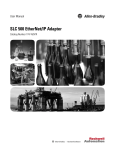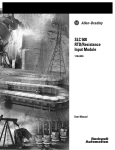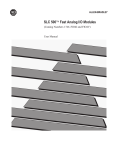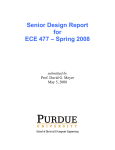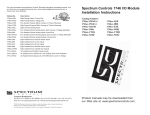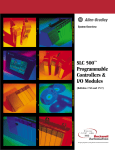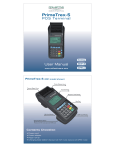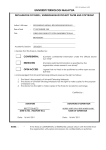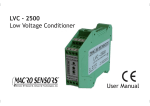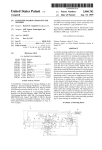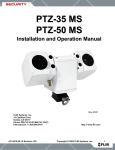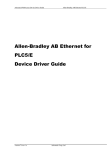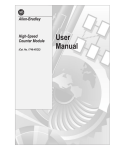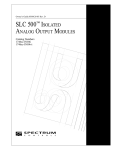Download Allen-Bradley Ethernet Driver Help
Transcript
Allen-Bradley Ethernet Driver Help © 2015 Kepware Technologies Allen-Bradley Ethernet Driver Help 2 Table of Contents Table of Contents 2 Allen-Bradley Ethernet Driver Help 4 Overview 4 Device Setup 5 Communications Parameters 6 Protocol Parameters 7 SLC 500 Slot Configuration 8 Modular I/O Selection Guide 9 Optimizing Your Allen-Bradley Ethernet Communications 11 Data Types Description 12 Address Descriptions 13 13 General Addressing Output Files 13 Input Files 14 Status Files 15 Binary Files 16 Timer Files 17 Counter Files 17 Control Files 18 Integer Files 19 Float Files 19 ASCII Files 20 String Files 20 SLC 5/05 Open Addressing 21 PLC-5 Family and SoftPLC Addressing 21 BCD Files 21 PID Files 22 Message Files 23 Block Transfer Files 23 Error Descriptions 25 Address <address> is out of range for the specified device or register. 26 Array size is out of range for address <address>. 26 Array support is not available for the specified address: <address>. 26 Data type <type> is not valid for device address <address>. 26 Device address <address> contains a syntax error. 26 Device address <address> is not supported by model <model name>. 26 www. kepware.com Allen-Bradley Ethernet Driver Help 3 Device address <address> is read only. 27 Device <device name> is not responding. 27 Missing address. 27 Unable to read data starting at address <address> on device <device name>. Frame received contains errors. 27 Unable to read data starting at address <address> on device <device name>. [STS=<value>, EXT STS=<value>]. 28 Unable to write to <address> on device <device name>. 28 Unable to write to address <address> on device <device name>. Frame received contains errors. 29 Unable to write to address <address> on device <device name>. [STS=<value>, EXT STS=<value>]. 29 Winsock initialization failed (OS error = n). 29 Winsock V1.1 or higher must be installed to use the Allen-Bradley Ethernet device driver. 30 Index 31 www. kepware.com Allen-Bradley Ethernet Driver Help 4 Allen-Bradley Ethernet Driver Help Help version 1.035 CONTENTS Overview What is the Allen-Bradley Ethernet Driver? Device Setup How do I configure a device for use with this driver? Optimizing Allen-Bradley Ethernet Communications How do I get the best performance from the Allen-Bradley Ethernet Driver? Data Types Description What data types are supported by this driver? Address Descriptions How do I address a data location on an Allen-Bradley Ethernet device? Error Descriptions What error messages are produced by the Allen-Bradley Ethernet Driver? Overview The Allen-Bradley Ethernet Driver provides an easy and reliable way to connect Allen-Bradley Ethernet devices to OPC Client applications, including HMI, SCADA, Historian, MES, ERP and countless custom applications. This driver supports the Allen Bradley SLC 5/05 series, PLC-5 series, and SoftPLC PLCs. Address ranges are open to support future models for this series of PLCs. www. kepware.com Allen-Bradley Ethernet Driver Help 5 Device Setup Supported Devices SLC 5/05 processor* PLC-5 series (excluding the PLC-5/250 series) SoftPLC *Address ranges have been opened up in the driver to allow for future devices. Therefore, the driver may still support a device even if it is not listed above. Communication Protocol Allen-Bradley Ethernet Timeout Parameters Connect Timeout This parameter specifies the time that the driver waits for a connection to be made with a device. The valid range is 1 to 60 seconds. Request Timeout This parameter specifies the time that the driver waits on a response from the device before giving up and going on to the next request. The valid range is 100 to 30000 milliseconds. Retry Attempts This parameter specifies the number of times that the driver attempt a message before giving up and going on to the next message. The valid range is 1 to 10. Cable Connections www. kepware.com Allen-Bradley Ethernet Driver Help 6 Communications Parameters Descriptions of the parameters are as follows: l l l Port Number: This parameter specifies the port number that the remote device is configured to use. The default setting is 2222. Protocol: The Allen-Bradley Ethernet Driver connects to the supported devices using Transfer Control Protocol (TCP). Winsock V1.1 or higher is required. Block Request Size: This parameter specifies the number of bytes that may be requested from a device at one time. To refine the driver's performance, configure the request size to one of the following settings: 32, 64, 128, 256, 512, 1024 or 2000 bytes. The default setting is 512 bytes. Note: For Boolean arrays, the block size is the bit equivalent (or, block size multiplied by 8). For example, a block size of 512 bytes is equal to 512 * 8 = 4096 bits. www. kepware.com Allen-Bradley Ethernet Driver Help 7 Protocol Parameters Descriptions of the parameters are as follows: l Destination Node Address (DST): This parameter specifies the destination node address. For DF1 gateway applications, enter the node address of the destination device. For non-DF1 gateway applications, leave the node address at the default setting. The default setting is 0. Note: The destination device is the DH+ or DH-485 device. www. kepware.com Allen-Bradley Ethernet Driver Help 8 SLC 500 Slot Configuration SLC 5/05 models (modular I/O racks) must be configured for use with the Allen-Bradley Ethernet Driver if the I/O is accessed by the driver. Up to 30 slots may be configured per device. Descriptions of the parameters are as follows: l l Slot/Module: This list-box is used to select the slot to be configured. Available Modules: This list-box is used to select an available module. The module selections available are the same as those in the Allen Bradley APS software. l Add: When clicked, the selected module is added. l Remove: When clicked, the selected module is removed. Important: Users must know the number of input and output words in each slot. In order to address the I/O in a particular slot, all slots up to and including that slot must be configured with I/O. For example, if a user is only interested in the I/O in slot 3, the I/O for slots 1 and 2 must be configured. Note: For information on the number of input and output words available for each I/O module, refer to Modular I/O Selection Guide. www. kepware.com Allen-Bradley Ethernet Driver Help 9 Modular I/O Selection Guide The following table lists the number of input and output words available for each I/O module in the Slot Configuration list. Module Type Input Words Output Words 1746-I*8 Any 8 pt Discrete Input Module 1 0 1746-I*16 Any 16 pt Discrete Input Module 1 0 1746-I*32 Any 32 pt Discrete Input Module 2 0 1746-O*8 Any 8 pt Discrete Output Module 0 1 1746-O*16 Any 16 pt Discrete Output Module 0 1 1746-O*32 Any 32 pt Discrete Output Module 0 2 1746-IA4 4 Input 100/120 VAC 1 0 1746-IA8 8 Input 100/120 VAC 1 0 1746-IA16 16 Input 100/120 VAC 1 0 1746-IB8 8 Input (Sink) 24 VDC 1 0 1746-IB16 16 Input (Sink) 24 VDC 1 0 1746-IB32 32 Input (Sink) 24 VDC 2 0 1746-IG16 16 Input [TTL] (Source) 5 VDC 1 0 1746-IM4 4 Input 200/240 VAC 1 0 1746-IM8 8 Input 200/240 VAC 1 0 1746-IM16 16 Input 200/240 VAC 1 0 1746-IN16 16 Input 24 VAC/VDC 1 0 1746-ITB16 16 Input [Fast] (Sink) 24 VDC 1 0 1746-ITV16 16 Input [Fast] (Source) 24 VDC 1 0 1746-IV8 8 Input (Source) 24 VDC 1 0 1746-IV16 16 Input (Source) 24 VDC 1 0 1746-IV32 32 Input (Source) 24 VDC 2 0 1746-OA8 8 Output (Triac) 100/240 VAC 0 1 1746-OA16 16 Output (Triac) 100/240 VAC 0 1 1746-OB8 8 Output [Trans] (Source) 10/50 VDC 0 1 1746-OB16 16 Output [Trans] (Source) 10/50 VDC 0 1 1746-OB32 32 Output [Trans] (Source) 10/50 VDC 0 2 1746-OBP16 16 Output [Trans 1 amp] (SRC) 24 VDC 0 1 1746-OV8 8 Output [Trans] (Sink) 10/50 VDC 0 1 1746-OV16 16 Output [Trans] (Sink) 10/50 VDC 0 1 1746-OV32 32 Output [Trans] (Sink) 10/50 VDC 0 2 1746-OW4 4 Output [Relay] VAC/VDC 0 1 1746-OW8 8 Output [Relay] VAC/VDC 0 1 1746-OW16 16 Output [Relay] VAC/VDC 0 1 1746-OX8 8 Output [Isolated Relay] VAC/VDC 0 1 1746-OVP16 16 Output [Trans 1 amp] (Sink) 24VDC3 0 1 1746-IO4 2 In 100/120 VAC 2 Out [Rly] VAC/VDC3 1 1 1746-IO8 4 In 100/120 VAC 4 Out [Rly] VAC/VDC4 1 1 1746-IO12 6 In 100/120 VAC 6 Out [Rly] VAC/VDC 1 1 1746-NI4 4 Ch Analog Input 4 0 1746-NIO4I Analog Comb 2 in & 2 Current Out 2 2 1746-NIO4V Analog Comb 2 in & 2 Voltage Out 2 2 1746-NO4I 4 Ch Analog Current Output 0 4 1746-NO4V 4 Ch Analog Voltage Output 0 4 1746-NT4 4 Ch Thermocouple Input Module 8 8 1746-NR4 4 Ch Rtd/Resistence Input Module 8 8 1746-HSCE High-Speed Counter/Encoder 8 1 1746-HS Single Axis Motion Controller 4 4 1746-OG16 16 Output [TLL] (SINK) 5 VDC 0 1 1746-BAS Basic Module 500 5/01 Configuration 8 8 www. kepware.com Allen-Bradley Ethernet Driver Help 10 1746-BAS Basic Module 5/02 Configuration 8 8 1747-DCM Direct Communication Module (1/4 Rack) 2 2 1747-DCM Direct Communication Module (1/2 Rack) 4 4 1747-DCM Direct Communication Module (3/4Rack) 6 6 1747-DCM Direct Communication Module (Full Rack) 8 8 1747-SN Remote I/O Scanner 32 32 1747-DSN Distributed I/O Scanner 7 Blocks 8 8 1747-DSN Distributed I/O Scanner 30 Blocks 32 32 1747-KE Interface Module, Series A 1 0 1747-KE Interface Module, Series B 8 8 1746-NI8 8 Ch Analog Input, Class 1 8 8 1746-NI8 8 Ch Analog Input, Class 3 16 12 1746-IC16 16 Input (Sink) 48 VDC 1 0 1746-IH16 16 Input [Trans] (Sink) 125 VDC 1 0 1746-OAP12 12 Output [Triac] 120/240 VDC 0 1 1746-OB6EI 6 Output [Trans] (Source) 24 VDC 0 1 1746-OB16E 16 Output [Trans] (Source) Protected 0 1 1746-OB32E 32 Output [Trans] (Source) 10/50 VDC 0 2 1746-OBP8 8 Output [Trans 2 amp] (Source) 24 VDC 0 1 1746-IO12DC 6 Input 12 VDC, 6 Output [Rly 1 1 1746-INI4I Analog 4 Ch. Isol. Current Input 8 8 1746-INI4VI Analog 4 Ch. Isol. Volt./Current Input 8 8 1746-INT4 4 Ch. Isolated Thermocouple Input 8 8 1746-NT8 Analog 8 Ch Thermocouple Input 8 8 1746-HSRV Motion Control Module 12 8 1746-HSTP1 Stepper Controller Module 8 8 1747-MNET MNET Network Comm Module 0 0 1747-QS Synchronized Axes Module 32 32 1747-QV Open Loop Velocity Control 8 8 1747-RCIF Robot Control Interface Module 32 32 1747-SCNR ControlNet SLC Scanner 32 32 1747-SDN DeviceNet Scanner Module 32 32 1394-SJT GMC Turbo System 32 32 1203-SM1 SCANport Comm Module - Basic 8 8 1203-SM1 SCANport Comm Module - Enhanced 32 32 AMCI-1561 AMCI Series 1561 Resolver Module 8 8 www. kepware.com Allen-Bradley Ethernet Driver Help 11 Optimizing Your Allen-Bradley Ethernet Communications The Allen-Bradley Ethernet Driver has been designed to provide the best performance with the least amount of impact on the system's overall performance. While the Allen-Bradley Ethernet Driver is fast, there are a couple of guidelines that can be used in order to control and optimize the application and gain maximum performance. Our server refers to communications protocols like Allen-Bradley Ethernet as a channel. Each channel defined in the application represents a separate path of execution in the server. Once a channel has been defined, a series of devices must then be defined under that channel. Each of these devices represents a single Allen-Bradley PLC from which data is collected. While this approach to defining the application provides a high level of performance, it doesn't take full advantage of the Allen-Bradley Ethernet Driver or the network. An example of how the application may appear when configured using a single channel is shown below. Each device appears under a single Allen-Bradley Ethernet channel. In this configuration, the driver must move from one device to the next as quickly as possible in order to gather information at an effective rate. As more devices are added or more information is requested from a single device, the overall update rate begins to suffer. If the Allen-Bradley Ethernet Driver could only define one single channel, then the example shown above would be the only option available; however, the Allen-Bradley Ethernet Driver can define up to 256 channels. Using multiple channels distributes the data collection workload by simultaneously issuing multiple requests to the network. An example of how the same application may appear when configured using multiple channels to improve performance is shown below. Each device has now been defined under its own channel. In this new configuration, a single path of execution is dedicated to the task of gathering data from each device. If the application has 256 or fewer devices, it can be optimized exactly how it is shown here. The performance can improve even if the application has more than 256 devices. While 256 or fewer devices may be ideal, the application still benefits from additional channels. Although spreading the device load across all channels causes the server to move from device to device again, it can do so with far fewer devices to process on a single channel. www. kepware.com Allen-Bradley Ethernet Driver Help 12 Data Types Description Data Type Description Boolean Single bit Byte Unsigned 8-bit value Char Signed 8-bit value Word Unsigned 16-bit value Short Signed 16-bit value DWord Unsigned 32-bit value Long Signed 32-bit value BCD Two-byte packed BCD, four decimal digits LBCD Four-byte packed BCD, eight decimal digits Float 32-bit IEEE floating-point String Null-terminated character array Note: The DWord, Long, and LBCD data types are not native to any of the PLC models. When referencing a 16-bit location as a 32-bit value, the location referenced is the low word and the next successive location is the high word. For example, if N7:10 is selected as a DWord data type, N7:10 is the low word and N7:11 the high word. www. kepware.com Allen-Bradley Ethernet Driver Help 13 Address Descriptions Address specifications vary depending on the model in use. Select a link from the following list to obtain specific address information for the model of interest. General Addressing SLC 5/05 Open Addressing PLC-5 Family and Soft PLC Addressing General Addressing The general addresses below pertain to SLC 5/05, PLC-5, and SoftPLC. Output Files Input Files Status Files Binary Files Timer Files Counter Files Control Files Integer Files Float Files ASCII Files String Files See Also: SLC 5/05 Open Addressing PLC-5 Family and SoftPLC Addressing Output Files The syntax for accessing data in the output file differs depending on the PLC model. Data locations are read / write for PLC-5 and SoftPLC models and read only for all other models. The default data type for all syntax is shown in bold. PLC-5 and SoftPLC Model Syntax Syntax Data Type O:<word> Short, Word, BCD O:<word>/<bit> Boolean O:<word>/<bit>[rows][cols] Boolean* O:<word>/<bit>[cols] Boolean* O/bit Boolean O/bit[rows][cols] Boolean* O/bit[cols] Boolean* *Array types Note: Word and bit address information is in octal for PLC-5 and SoftPLC models. This follows the convention of the programming software. SLC 5/05 Open Models (Modular I/O) Syntax Syntax Data Type O:<slot> Short, Word, BCD O:<slot>.<word> Short, Word, BCD O:<slot>/<bit> Boolean O:<slot>/<bit>[rows][cols] Boolean* O:<slot>/<bit>[cols] Boolean* O:<slot>.<word>/<bit> Boolean O:<slot>.<word>/<bit>[rows][cols] Boolean* O:<slot>.<word>/<bit>[cols] Boolean* *Array types Slot and Word Configurations www. kepware.com Allen-Bradley Ethernet Driver Help 14 The following slot and word locations are allowed for each model. For information, refer to Device Setup. PLC Model Min Slot Max. Slot Max. Word SLC 5/05 Open 1 30 * PLC-5 Family NA NA 277 (octal) SoftPLC NA NA 777 (octal) *The number of input or output words available for each I/O module can be found in the Modular I/O Selection Guide. Examples All addresses are in octal. PLC-5 / SoftPLC Addresses O:0 Word 0 O:37 Word 31 (37 octal=31 decimal) O/42 Bit 34 (42 octal=34 decimal) O:2/2 Bit 2 word 2 (same as O/42) O/20[9] 9 element Boolean array starting at bit 16 (20 octal=16 decimal) O/37[8][11] 8 by 11 element Boolean array starting at bit 31 (37 octal=31 decimal) O:47/5[3] 3 element Boolean array starting at bit 5 word 39 (47 octal=39 decimal) O:11/13[3][7] 3 by 7 element Boolean array starting at bit 11 (13 octal=11 decimal) word 9 (11 octal=9 decimal) SLC 5/05 Addresses O:1 Word 0 slot 1 O:1.0 Word 0 slot 1 (same as O:1) O:12 Word 0 slot 12 O:12.2 Word 2 slot 12 O:4.0/0 Bit 0 word 0 slot 4 O:4/0 Bit 0 slot 4 (same as O:4.0/0) O:4.2/0 Bit 0 word 2 slot 4 O:4/32 Bit 32 slot 4 (same as O:4.2/0) O:2.12/3[17] 17 element Boolean array starting at bit 3 word 12 slot 2 O:2.2/0[12][12] 12 by 12 element Boolean array starting at bit 0 word 2 slot 2 O:2/43[5] 5 element Boolean array starting at bit 43 slot 2 O:2/11[6][12] 6 by 12 element Boolean array starting at bit 11 slot 2 Input Files The syntax for accessing data in the input file differs depending on the PLC model. Data locations are read / write for PLC-5 models and read only for all other models. The default data type for all syntax is shown in bold. PLC-5 and SoftPLC Model Syntax Syntax Data Type I:<word> Short, Word, BCD I:<word>/<bit> Boolean I:<word>/<bit>[rows][cols] Boolean* I:<word>/<bit>[cols] Boolean* I/bit Boolean I/bit[rows][cols] Boolean* I/bit[cols] Boolean* *Array types Note: Word and bit address information is in octal for PLC-5 and SoftPLC models. This follows the convention of the programming software. www. kepware.com Allen-Bradley Ethernet Driver Help 15 SLC 5/05 Open Models (Modular I/O) Syntax Syntax Data Type I:<slot> Short, Word, BCD I:<slot>.<word> Short, Word, BCD I:<slot>/<bit> Boolean I:<slot>/<bit>[rows][cols] Boolean* I:<slot>/<bit>[cols] Boolean* I:<slot>.<word>/<bit> Boolean I:<slot>.<word>/<bit>[rows][cols] Boolean* I:<slot>.<word>/<bit>[cols] Boolean* *Array types Slot and Word Locations The following slot and word locations are allowed for each model. For more information, refer to Device Setup. PLC Model Min Slot Max. Slot Max. Word SLC 5/05 Open 1 30 * PLC-5 Family NA NA 277 (octal) SoftPLC Family NA NA 777 (octal) *The number of input or output words available for each I/O module can be found in the Modular I/O Selection Guide. Examples All addresses are in octal. PLC-5 / SoftPLC Addresses I:0 Word 0 I:10 Word 8 (10 octal = 8 decimal) I/20 Bit 16 (20 octal = 16 decimal) I:1/0 Bit 0 word 1 (same as I/20) I/20[9] 9 element Boolean array starting at bit 16 (20 octal = 16 decimal) I/37[8][11] 8 by 11 element Boolean array starting at bit 31 (37 octal = 31 decimal) I:47/5[3] 3 element Boolean array starting at bit 5 word 39 (47 octal = 39 decimal) I:11/13[3][7] 3 by 7 element Boolean array starting at bit 11 (13 octal = 11 decimal) word 9 (11 octal = 9 decimal) SLC 5/05 Addresses I:1 Word 0 slot 1 I:1.0 Word 0 slot 1 (same as I:1) I:12 Word 0 slot 12 I:12.2 Word 2 slot 12 I:4.0/0 Bit 0 word 0 slot 4 I:4/0 Bit 0 slot 4 (same as I:4.0/0) I:4.2/0 Bit 0 word 2 slot 4 I:4/32 Bit 32 slot 4 (same as I:4.2/0) I:2.12/3[17] 17 element Boolean array starting at bit 3 word 12 slot 2 I:2.2/0[12][12] 12 by 12 element Boolean array starting at bit 0 word 2 slot 2 I:2/43[5] 5 element Boolean array starting at bit 43 slot 2 I:2/11[6][12] 6 by 12 element Boolean array starting at bit 11 slot 2 Status Files To access Status files, specify a word (and optionally, a bit in the word). The default data type for all syntax is shown in bold. www. kepware.com Allen-Bradley Ethernet Driver Help 16 Syntax Data Type S:<word> Short, Word, BCD, DWord, Long, LBCD S:<word> [rows][cols] Short, Word, BCD, DWord, Long, LBCD* S:<word> [cols] Short, Word, BCD, DWord, Long, LBCD* S:<word>/<bit> Boolean S:<word>/<bit> [rows][cols] Boolean* S:<word>/<bit> [cols] Boolean* S/bit Boolean S/bit [rows][cols] Boolean* S/bit [cols] Boolean* *Array types Note: The number of array elements (in bytes) cannot exceed the block request size specified. This means that array size cannot exceed 16 words given a block request size of 32 bytes. For more information, refer to Block Request Size. Word Locations The following Word locations are allowed for each model. The maximum word location is one less when accessing as a 32-bit data type (Long, DWord, or Long BCD). PLC Model Max. Word SLC 5/05 Open 999 PLC-5 Family 999 SoftPLC 31 Example Description S:0 Word 0. S/26 Bit 26. S:4/15 Bit 15 word 4. S:10 [16] 16 element array starting at word 10. S:0 [4][8] 4 by 8 element array starting at word 0. S/9 [5] 5 element Boolean array starting at bit 9. S/11 [3][7] 3 by 7 element Boolean array starting at bit 11. S:6/1 [6] 6 element Boolean array starting at bit 1 word 6. S:13/5 [2][3] 2 by 3 element Boolean array starting at bit 5 word 13. Binary Files To access Binary files, specify a file number and a word (and optionally, a bit in the word). The default data type for all syntax is shown in bold. Syntax Data Type B<file>:<word> Short, Word, BCD, DWord, Long, LBCD B<file>:<word> [rows][cols] Short, Word, BCD, DWord, Long, LBCD* B<file>:<word> [cols] Short, Word, BCD, DWord, Long, LBCD* B<file>:<word>/<bit> Boolean B<file>:<word>/<bit> [rows][cols] Boolean* B<file>:<word>/<bit> [cols] Boolean* B<file>/bit Boolean B<file>/bit [rows][cols] Boolean* B<file>/bit [cols] Boolean* *Array types Note: The number of array elements (in bytes) cannot exceed the block request size specified. This means that array size cannot exceed 16 words given a block request size of 32 bytes. For more information, refer to Block Request Size. File Numbers and Word Locations www. kepware.com Allen-Bradley Ethernet Driver Help 17 The following file numbers and word locations are allowed for each model. The maximum word location is one less when accessing as a 32-bit data type (Long, DWord, or Long BCD). PLC Model File Number Max. Word SLC 5/05 Open 3, 9-999 999 PLC-5 Family 3-999 1999 SoftPLC 3-9999 9999 Example Description B3:0 Word 0 B3/26 Bit 26 B12:4/15 Bit 15 word 4 B3:10 [20] 20 element array starting at word 10 B15:0 [6][6] 6 by 6 element array starting at word 0 B3/7 [8] 8 element Boolean array starting at bit 7 B3/32 [6][9] 6 by 9 element Boolean array starting at bit 32 B3:11/2 [12] 12 element Boolean array starting at bit 2 word 11 B3:23/4 [5][8] 5 by 8 element Boolean array starting at bit 4 word 23 Timer Files Timer files are a structured type whose data is accessed by specifying a file number, an element and a field. The default data type depends on the field being accessed. Integer fields receive a default data type of Word. Syntax Data Type T<file>:<element>.<field> Depends on field File Numbers and Elements The following file numbers and maximum element are allowed for each model. PLC Model File Number Max. Element SLC 5/05 Open 4, 9-999 999 PLC-5 Family 3-999 1999 SoftPLC 3-9999 9999 The following fields are allowed for each element. Refer to the PLC documentation for the meaning of each field. Element Field Data Type Access ACC Short, Word Read/Write PRE Short, Word Read/Write DN Boolean Read Only TT Boolean Read Only EN Boolean Read Only Example Description T4:0.ACC Accumulator of timer 0 file 4. T4:10.DN Done bit of timer 10 file 4. T15:0.PRE Preset of timer 0 file 15. Counter Files Counter files are a structured type whose data is accessed by specifying a file number, an element and a field. The default data type depends on the field being accessed. Integer fields receive a default data type of Word. Syntax Data Type C<file>:<element>.<field> Depends on field File Numbers and Elements The following file numbers and maximum element are allowed for each model. www. kepware.com Allen-Bradley Ethernet Driver Help 18 PLC Model File Number Max. Element SLC 5/05 Open 5, 9-999 999 PLC-5 Family 3-999 1999 SoftPLC 3-9999 9999 The following fields are allowed for each element. Refer to the PLC documentation for the meaning of each field. Element Field Data Type Access ACC Short, Word Read/Write PRE Short, Word Read/Write UA Boolean Read Only UN Boolean Read Only OV Boolean Read Only DN Boolean Read Only CD Boolean Read Only CU Boolean Read Only Example Description C5:0.ACC Accumulator of counter 0 file 5 C5:10.DN Done bit of counter 10 file 5 C15:0.PRE Preset of counter 0 file 15 Control Files Control files are a structured type whose data is accessed by specifying a file number, an element and a field. The default data type depends on the field being accessed. Integer fields receive a default data type of Word. Syntax Data Type R<file>:<element>.<field> Depends on field File Numbers and Elements The following file numbers and maximum element are allowed for each model. PLC Model File Number Max. Element SLC 5/05 Open 6, 9-999 999 PLC-5 Family 3-999 1999 SoftPLC 3-9999 9999 The following fields are allowed for each element. Refer to the PLC documentation for the meaning of each field. Element Field Data Type Access LEN Short, Word Read/Write POS Short, Word Read/Write FD Boolean Read Only IN Boolean Read Only UL Boolean Read Only ER Boolean Read Only EM Boolean Read Only DN Boolean Read Only EU Boolean Read Only EN Boolean Read Only Examples Description R6:0.LEN Length field of control 0 file 6 R6:10.DN Done bit of control 10 file 6 R15:18.POS Position field of control 18 file 15 www. kepware.com Allen-Bradley Ethernet Driver Help 19 Integer Files To access Integer files, specify a file number and a word (and optionally, a bit in the word). The default data type for all syntax is shown in bold. Syntax Data Type N<file>:<word> Short, Word, BCD, DWord, Long, LBCD N<file>:<word> [rows][cols] Short, Word, BCD, DWord, Long, LBCD* N<file>:<word> [cols] Short, Word, BCD, DWord, Long, LBCD* N<file>:<word>/<bit> Boolean N<file>:<word>/<bit> [rows][cols] Boolean* N<file>:<word>/<bit> [cols] Boolean* N<file>/bit Boolean N<file>/bit [rows][cols] Boolean* N<file>/bit [cols] Boolean* *Array types Note: The number of array elements (in bytes) cannot exceed the block request size specified. This means that array size cannot exceed 16 words given a block request size of 32 bytes. For more information, refer to Block Request Size. File Numbers and Word Locations The following file numbers and maximum word locations are allowed for each model. The maximum word location is one less when accessing as a 32-bit data type (Long, DWord or Long BCD). PLC Model File Number Max. Word SLC 5/05 Open 7, 9-999 999 PLC-5 Family 3-999 1999 SoftPLC 3-9999 9999 Example Description N7:0 Word 0 N7/26 Bit 26 N12:4/15 Bit 15 word 4 N7:10 [8] 8 element array starting at word 10 N15:0 [4][5] 4 by 5 element array starting at word 0 N7/12 [9] 9 element Boolean array starting at bit 12 N7/19 [3][11] 3 by 11 element Boolean array starting at bit 19 N7:7/0 [10] 10 element Boolean array starting at bit 0 word 7 N7:29/13 [2][15] 2 by 15 element Boolean array starting at bit 13 word 29 Float Files To access Float files, specify a file number and an element. The only data type allowed is Float. Syntax Data Type F<file>:<element> Float F<file>:<element> [rows][cols] Float array F<file>:<element> [cols] Float array Note: The number of array elements (in bytes) cannot exceed the block request size specified. This means array size cannot exceed 8 floats given a block request size of 32 bytes. For more information, refer to Block Request Size. File Numbers and Word Locations The following file numbers and maximum word locations are allowed for each model. PLC Model File Number www. kepware.com Max. Word Allen-Bradley Ethernet Driver Help 20 SLC 5/05 Open 8-999 999 PLC-5 Family 3-999 1999 SoftPLC 3-9999 9999 Example Description F8:0 Float 0 F8:10 [16] 16-element array starting at word 10 F15:0 [4][4] 16-element array starting at word 0 ASCII Files To access ASCII file data, specify a file number and character location. The default data type for all syntax is shown in bold. Syntax Data Type A<file>:<char> Char, Byte* A<file>:<char> [rows][cols] Char, Byte* A<file>:<char> [cols] Char, Byte* A<file>:<word offset>/length String** Note: The number of array elements cannot exceed the block request size specified. For more information, refer to Block Request Size. *The PLC packs two characters per word in the file, with the high byte containing the first character and the low byte containing the second character. The PLC programming software allows access at the word level or twocharacter level. The AB Ethernet driver allows accessing to the character level. Examples are as follows: l l Using the programming software A10:0=AB would result in 'A' being stored in the high byte of A10:0 and 'B' being stored in the low byte. Using the AB Ethernet driver, two assignments, A10:0=A and A10:1=B, would result in the same data being stored in the PLC memory. **Referencing this file as string data allows access to data at word boundaries like the programming software. The length can be up to 236 characters. If a string that is sent to the device is smaller in length than the length specified by the address, the driver null terminates the string before sending it down to the controller. File Numbers and Character Locations The following file numbers and maximum character locations are allowed for each model. PLC Model File Number Max. Character SLC 5/05 Open 9-999 1999 PLC-5 Family 3-999 1999 SoftPLC N/A N/A Note: All SLC 500 PLCs do not support ASCII file types. For more information, refer to the PLC documentation. Example Description A9:0 Character 0 (high byte of word 0) A27:10 [80] 80-character array starting at character 10 A15:0 [4][16] 4 by 16 character array starting at character 0 A62:0/32 32-character string starting at word offset 0 String Files To access data in a String file, specify a file number and an element. The only data type allowed is string, which are 82-character null-terminated arrays. The driver places the null terminator based on the string length returned by the PLC. Syntax Data Type ST<file>:<element>.<field> String www. kepware.com Allen-Bradley Ethernet Driver Help 21 Note: Arrays of strings are not supported. File Numbers and Word Locations The following file numbers and maximum word locations are allowed for each model. PLC Model File Number Max. Word SLC 5/05 Open 9-999 999 PLC-5 Family 3-999 999 SoftPLC 3-9990 9999 Example Description ST9:0 String 0 ST18:10 String 10 SLC 5/05 Open Addressing Open Addressing The actual number of addresses available depends on the model of the PLC. The ranges have been opened up to allow for maximum flexibility with future models. If the driver finds at runtime that an address is not present in the device, it posts an error message and removes the tag from its scan list. Note: This model has no specific addressing. See Also: General Addressing PLC-5 Family and SoftPLC Addressing General Addressing General Addressing Model-Specific Addressing BCD Files PID Files Message Files Block Transfer Files BCD Files To access BCD files, specify a file number and a word. The only data types allowed are BCD and long BCD. The default data type is always BCD. Syntax Data Type D<file>:<word> BCD, LBCD D<file>:<word> [rows][cols] BCD, LBCD* D<file>:<word> [cols] BCD, LBCD* *Array types Note: The number of array elements (in bytes) cannot exceed the block request size specified. This means array size cannot exceed 16 BCDs given a block request size of 32 bytes. For more information, refer to Block Request Size. File Numbers and Word Locations The following file numbers and maximum word locations are allowed for each model. PLC Model File Number Max. Word SLC 5/05 Open NA NA PLC-5 Family 3-999 1999 SoftPLC 3-9999 9999 Example Description www. kepware.com Allen-Bradley Ethernet Driver Help 22 D9:0 Word 0 D27:10 [16] 16 element array starting at word 10 D15:0 [4][8] 32 element array starting at word 0 PID Files PID files are a structured type whose data is accessed by specifying a file number, an element and a field. The default data type depends on the field being accessed. Integer fields receive a default data type of Word. Syntax Data Type PD<file>:<element>.<field> Depends on field File Numbers and Elements The following file numbers and maximum element are allowed for each model. PLC Model File Number Max. Element SLC 5/05 Open NA NA PLC-5 Family 3-999 999 SoftPLC 3-9999 9999 The following fields are allowed for each element. Refer to the PLC documentation for the meaning of each field. Element Field Data Type Access SP Real Read/Write KP Real Read/Write KI Real Read/Write KD Real Read/Write BIAS Real Read/Write MAXS Real Read/Write MINS Real Read/Write DB Real Read/Write SO Real Read/Write MAXO Real Read/Write MINO Real Read/Write UPD Real Read/Write PV Real Read/Write ERR Real Read/Write OUT Real Read/Write PVH Real Read/Write PVL Real Read/Write DVP Real Read/Write DVN Real Read/Write PVDB Real Read/Write DVDB Real Read/Write MAXI Real Read/Write MINI Real Read/Write TIE Real Read/Write FILE Short, Word Read/Write ELEM Short, Word Read/Write EN Boolean Read/Write CT Boolean Read/Write CL Boolean Read/Write PVT Boolean Read/Write DO Boolean Read/Write SWM Boolean Read/Write CA Boolean Read/Write MO Boolean Read/Write www. kepware.com Allen-Bradley Ethernet Driver Help 23 PE Boolean Read/Write INI Boolean Read/Write SPOR Boolean Read/Write OLL Boolean Read/Write OLH Boolean Read/Write EWD Boolean Read/Write DVNA Boolean Read/Write DVHA Boolean Read/Write PVLA Boolean Read/Write PVHA Boolean Read/Write Example Description PD14:0.SP Set point field of PD 0 file 14 PD18:6.EN Status enable bit of PD 6 file 18 Message Files Message files are a structured type whose data is accessed by specifying a file number, an element and a field. The default data type depends on the field being accessed. Integer fields receive a default data type of Word. Syntax Data Type MG<file>:<element>.<field> Depends on field File Numbers and Elements The following file numbers and maximum element are allowed for each model. PLC Model File Number Max. Element SLC 5/05 Open NA NA PLC-5 Family 3-999 999 SoftPLC 3-9999 9999 The following fields are allowed for each element. Refer to the PLC documentation for the meaning of each field. Element Field Data Type Access ERR Short, Word Read/Write RLEN Short, Word Read/Write DLEN Short, Word Read/Write EN Boolean Read/Write ST Boolean Read/Write DN Boolean Read/Write ER Boolean Read/Write CO Boolean Read/Write EW Boolean Read/Write NR Boolean Read/Write TO Boolean Read/Write Example Description MG14:0.RLEN Requested length field of MG 0 file 14 MG18:6.CO Continue bit of MG 6 file 18 Block Transfer Files Block transfer files are a structured type whose data is accessed by specifying a file number, an element, and a field. The default data type depends on the field being accessed. Integer fields receive a default data type of Word. Syntax Data Type BT<file>:<element>.<field> Depends on field www. kepware.com Allen-Bradley Ethernet Driver Help 24 File Numbers and Elements The following file numbers and maximum element are allowed for each model. PLC Model File Number Max. Element SLC 5/05 Open NA NA PLC-5 Family 3-999 1999 SoftPLC 3-9999 9999 The following fields are allowed for each element. Refer to the PLC documentation for the meaning of each field. Element Field Data Type Access RLEN Short, Word Read/Write DLEN Short, Word Read/Write FILE Short, Word Read/Write ELEM Short, Word Read/Write RW Boolean Read/Write ST Boolean Read/Write DN Boolean Read/Write ER Boolean Read/Write CO Boolean Read/Write EW Boolean Read/Write NR Boolean Read/Write TO Boolean Read/Write Example Description BT14:0.RLEN Requested length field of BT 0 file 14 BT18:6.CO Continue bit of BT 6 file 18 www. kepware.com Allen-Bradley Ethernet Driver Help 25 Error Descriptions The following messages may be generated. Click on the link for a description of the message. Address Validation Missing address Device address <address> contains a syntax error. Address <address> is out of range for the specified device or register. Device address <address> is not supported by model <model name>. Data type <type> is not valid for device address <address>. Device address <address> is read only. Array size is out of range for address <address>. Array support is not available for the specified address: <address>. Communications Error Messages Winsock initialization failed (OS Error = n). Winsock V1.1 or higher must be installed to use the Allen-Bradley Ethernet device driver. Device Status Messages Device <device name> is not responding. Unable to write to <address> on device <device name>. Device-Specific Messages Unable to read data starting at address <address> on device <device name>. Frame received contains errors. Unable to read data starting at address <address> on device <device name>. [STS=<value>, EXT STS=<value>]. Unable to write to address <address> on device <device name>. Frame received contains errors. Unable to write to address <address> on device <device name>. [STS=<value>, EXT STS=<value>]. www. kepware.com Allen-Bradley Ethernet Driver Help 26 Address <address> is out of range for the specified device or register. Error Type: Warning Possible Cause: A tag address that has been specified statically references a location that is beyond the range of supported locations for the device. Solution: Verify the address is correct; if it is not, re-enter it in the client application. Array size is out of range for address <address>. Error Type: Warning Possible Cause: A tag address that has been specified statically is requesting an array size that is too large for the address type or block size of the driver. Solution: Re-enter the address in the client application to specify a smaller value for the array or a different starting point. Array support is not available for the specified address: <address>. Error Type: Warning Possible Cause: A tag address that has been specified statically contains an array reference for an address type that doesn't support arrays. Solution: Re-enter the address in the client application to remove the array reference or correct the address type. Data type <type> is not valid for device address <address>. Error Type: Warning Possible Cause: A tag address that has been specified statically has been assigned an invalid data type. Solution: Modify the requested data type in the client application. Device address <address> contains a syntax error. Error Type: Warning Possible Cause: A tag address that has been specified statically contains one or more invalid characters. Solution: Re-enter the address in the client application. Device address <address> is not supported by model <model name>. Error Type: Warning Possible Cause: www. kepware.com Allen-Bradley Ethernet Driver Help 27 A tag address that has been specified statically references a location that is valid for the communications protocol but not supported by the target device. Solution: Verify the address is correct; if it is not, re-enter it in the client application. Also verify that the selected model name for the device is correct. Device address <address> is read only. Error Type: Warning Possible Cause: A tag address that has been specified statically has a requested access mode that is not compatible with what the device supports for that address. Solution: Change the access mode in the client application. Device <device name> is not responding. Error Type: Warning Possible Cause: 1. The Ethernet connection between the device and the host PC is broken. 2. The communication parameters for the Ethernet connection are incorrect. 3. The named device may have been assigned an incorrect IP address. 4. The response from the device took longer to receive than the amount of time specified in the "Request Timeout" device setting. Solution: 1. Verify the cabling between the PC and the device. 2. Verify that the correct port has been specified for the named device. 3. Verify that the IP address given to the named device matches that of the actual device. 4. Increase the Request Timeout setting so that the entire response can be handled. Missing address. Error Type: Warning Possible Cause: A tag address that has been specified statically has no length. Solution: Re-enter the address in the client application. Unable to read data starting at address <address> on device <device name>. Frame received contains errors. Error Type: Warning The type of error could be: www. kepware.com Allen-Bradley Ethernet Driver Help 28 1. An incorrect frame size received. 2. A TNS mismatch. 3. An invalid response command returned from the device. Possible Cause: 1. Misalignment of packets due to connection/disconnection between the PC and device. 2. Bad cabling connecting the devices that is causing noise. Solution: The driver recovers from the error without intervention. If this error occurs frequently, there may be an issue with the cabling or the device itself. Unable to read data starting at address <address> on device <device name>. [STS=<value>, EXT STS=<value>]. Error Type: Warning Possible Cause: 1. The address requested does not exist in the PLC. 2. The address requested cannot be accessed because the PLC is in an error state. 3. The communications parameters for the Ethernet connection are incorrect. Solution: 1. Verify the address exists in the PLC. 2. Verify the PLC is not in an error state. 3. Verify the communications parameters for the Ethernet connection are correct. 4. Verify the correct port is specified for the named device. 5. Verify the IP address given to the named device matches that of the actual device. Note: Check the status and extended status codes that are being returned by the PLC. The extended status code may not always be returned; thus, error information is contained within the status code. The codes are displayed in hexadecimal. Status code errors in the low nibble of the status code indicate errors found by the local node. The driver continues to retry reading these blocks of data periodically. Errors found by the local node occur when the KF module cannot see the destination PLC on the network for some reason. Status code errors in the high nibble of the status code indicate errors found by the PLC. These errors are generated when the block of data the driver is asking for is not available in the PLC. The driver does not ask for these blocks again after receiving this error. This error can be generated if the address does not exist in the PLC. Unable to write to <address> on device <device name>. Error Type: Warning Possible Cause: www. kepware.com Allen-Bradley Ethernet Driver Help 29 1. The Ethernet connection between the device and the host PC is broken. 2. The communication parameters for the Ethernet connection are incorrect. 3. The named device may have been assigned an incorrect IP address. Solution: 1. Verify the cabling between the PC and the device. 2. Verify that the correct port has been specified for the named device. 3. Verify that the IP address given to the named device matches that of the actual device. Unable to write to address <address> on device <device name>. Frame received contains errors. Error Type: Warning The Error Could Be: 1. Incorrect frame size received. 2. TNS mismatch. 3. Invalid response command returned from device. Possible Cause: 1. Misalignment of packets due to connection/disconnection between PC and device. 2. There is bad cabling connecting the devices causing noise. Solution: The driver recovers from this error without intervention. If this error occurs frequently, there may be an issue with the cabling or the device itself. Unable to write to address <address> on device <device name>. [STS=<value>, EXT STS=<value>]. Error Type: Warning Possible Cause: The address written to does not exist in the PLC. Solution: Check the status and extended status codes that are being returned by the PLC. Note that an extended status code may not always be returned and thus the error information is contained within the status code. The codes are displayed in hexadecimal. Status code errors in the low nibble of the status code indicate errors found by the local node. Errors found by the local node occur when the KF module cannot see the destination PLC on the network for some reason. Status code errors in the high nibble of the status code indicate errors found by the PLC. These errors are generated when the data location is not available in the PLC or is not writable. Winsock initialization failed (OS error = n). Error Type: Fatal OS Error: Indication 10091 Indicates that the underlying network subsystem is Wait a few seconds and restart the Possible Solution www. kepware.com Allen-Bradley Ethernet Driver Help 30 10067 not ready for network communication. driver. Limit on the number of tasks supported by the Windows Sockets implementation has been reached. Close one or more applications that may be using Winsock and restart the driver. Winsock V1.1 or higher must be installed to use the Allen-Bradley Ethernet device driver. Error Type: Fatal Possible Cause: The version number of the Winsock DLL found on the system is less than 1.1. Solution: Upgrade Winsock to version 1.1 or higher. www. kepware.com Allen-Bradley Ethernet Driver Help 31 Index A Address <address> is out of range for the specified device or register. 26 Address Descriptions 13 Array size is out of range for address <address>. 26 Array support is not available for the specified address: <address>. 26 ASCII Files 20 B BCD 12 BCD Files 21 Binary Files 16 Block Transfer Files 23 Boolean 12 Byte 12 C Char 12 Communications Parameters 6 Control Files 18 Counter Files 17 D Data type <type> is not valid for device address <address>. 26 Data Types Description 12 Destination Node Address 7 Device <device name> is not responding. 27 Device address <address> contains a syntax error. 26 Device address <address> is not supported by model <model name>. 26 Device address <address> is read only. 27 Device ID 5 Device Setup 5 DWord 12 F Float 12 Float Files 19 www. kepware.com Allen-Bradley Ethernet Driver Help 32 G General Addressing 13 I Input Files 14 Integer Files 19 L LBCD 12 Long 12 M Message 23 Missing address. 27 Modular I/O Selection Guide 9 N Network 5 O Optimizing Your Allen-Bradley Ethernet Communications 11 Output Files 13 Overview 4 P PID Files 22 PLC5 Addressing 21 Protocol Parameters 7 S Short 12 SLC5/05 21 www. kepware.com Allen-Bradley Ethernet Driver Help 33 SLC500 Slot Configuration 8 Status Files 15 String 12 String Files 20 T Timer Files 17 U Unable to read data starting at address <address> on device <device name>. [STS=<value>, EXT STS=<value>]. 28 Unable to read data starting at address <address> on device <device name>. Frame received contains errors. 27 Unable to write to <address> on device <device name>. 28 Unable to write to address <address> on device <device name>. Frame received contains errors. 29 Unable to write to address <address> on device <device name>. [STS=<value>, EXT STS=<value>]. 29 W Winsock initialization failed (OS error = n). 29 Winsock V1.1 or higher must be installed to use the Allen-Bradley Ethernet device driver. 30 Word 12 www. kepware.com


































